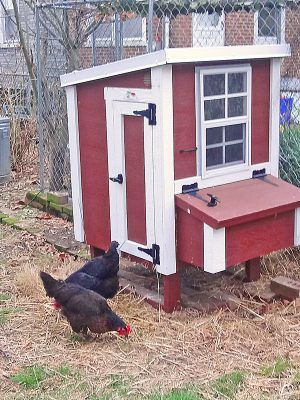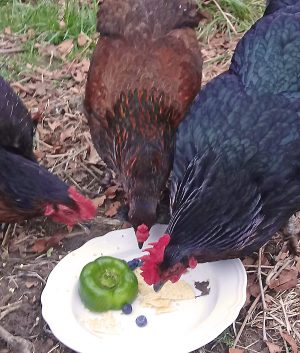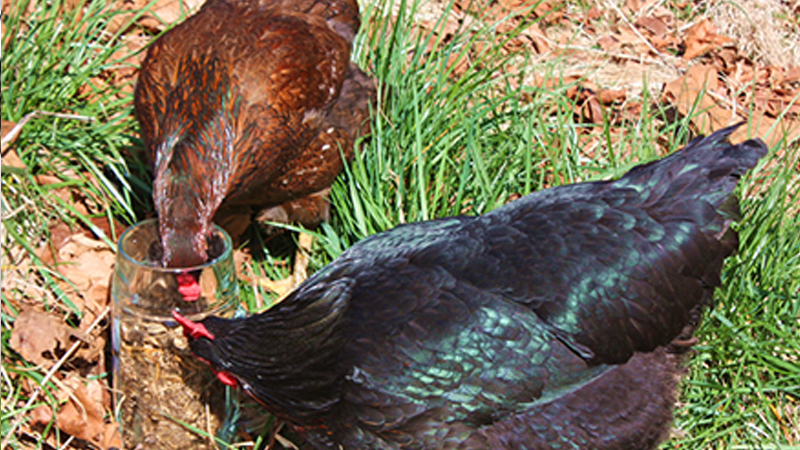Maureen Breen
 The humble backyard chicken could be the next innovation in keeping food waste out of landfills. Research from Philadelphia measured the amount of household food scraps that are typically fed to a backyard chicken. The results showed that the simple backyard chicken is a more economical, environmental, and desirable use of household food scraps than landfilling.
The humble backyard chicken could be the next innovation in keeping food waste out of landfills. Research from Philadelphia measured the amount of household food scraps that are typically fed to a backyard chicken. The results showed that the simple backyard chicken is a more economical, environmental, and desirable use of household food scraps than landfilling.
When Austin, Texas implemented a policy to pay residents $75 to purchase a chicken coop so that people could feed household food scraps to backyard chickens, they did not track the amount of diverted food waste. My research in Philadelphia is measuring the amount of food scraps consumed by a typical backyard chicken. Backyard chickens are omnivorous and can eat most of the same foods that humans eat or discard. Three criteria were used to evaluate the value of backyard chickens in reducing MSW — financial cost, environmental impact, and the EPA’s food waste recovery hierarchy.
Before performing any evaluations, I needed to know how much a typical backyard chicken eats. Eleven people volunteered to measure the food scraps they fed to their backyard chickens. Since Austin is the only municipality that currently has such a program, I used data from Austin and other financial data for the analysis.
 Running The Numbers
Running The Numbers
Eleven households in the Philadelphia metropolitan area weighed the food scraps fed to their 48 backyard chickens every day for one week a month from September 2018 to January 2019. Flocks ranged from two to nine chickens. The total weight of household food scraps fed to the backyard chickens for the five weeks studied was 349 pounds (lbs). When extrapolated to a full year of consumption, a backyard chicken is expected to consume approximately 1.6 lbs/week of food scraps, or 83.2 lbs/year.
Given Austin’s 2018 cost of $163/ton to collect and compost or dispose of organic MSW, each backyard chicken saves $6.76/year in MSW management costs. A common size flock of four chickens would save $27.04/year. In addition to data from Austin, I used 3.4%, the average municipal bond rate in 2018, as the discount interest rate, and 10 years as a chicken’s expected life. I also performed sensitivity analysis for these values, including payback period, net present value (NPV), internal rate of return (IRR), and profitability index (PI).
Payback
The payback period is the amount of time required for the cash inflows to equal the initial cost. In my research, the payback period is 2.80 years. That is, given the assumed input values, a municipality can expect to recover a cost of a $75/coop in 2.8 years. The highest initial cost that would still achieve a payback period of at least five years is $135 and the minimum annual cost savings necessary to achieve a payback period of five years is $15. The backyard chickens could eat approximately 55% of what they ate in my study and yield a payback period of five years.
Net Present Value
NPV is the sum of all the cash flows discounted at the assumed discount rate and length of time for the project. Based on the estimated values, the NPV is $150.90. That is, a municipality that pays citizens $75 to purchase a chicken coop can expect to gain $150.90 in present value dollars. Given the assumed input values, the highest initial cost that would yield a positive NPV is $225; a flock of four backyard chickens could eat approximately one-third of what they ate in my study and yield a positive NPV.
Internal Rate of Return: The IRR is the discount rate that breaks even. The IRR in my study is 34.1%. A municipality that pays citizens $75 to purchase a chicken coop can expect to earn a return of 34.1%. Given the assumed values, the minimum annual cost savings necessary to achieve an IRR of 3.4% is $9.00; a flock of four backyard chickens could eat one-third of what they ate in my study and yield a project with an IRR of 3.4%.
Profitability Index
The PI is the ratio of the present value of the program cash flows to the initial investment. Based on the assumed values, the PI is approximately 3.0. That is, a municipality that pays citizens $75 to purchase a chicken coop can expect to earn three times the positive cash flow, in present value dollars, over the project.
Backyard chickens are cost-effective at reducing the cost of MSW disposal. The sensitivity analysis revealed that the initial cost can be as high as $225, the annual savings can be as low as $2.25/backyard chicken, or $9.00/flock, the discount rate can be as high as 33.7% or the project length can be as short as 3.0 years without changing the results.
Climate Benefits
The impact to climate change was determined using a life cycle assessment based on data available in the Ecoinvent database 3.0. The Ecoinvent 3.0 data related to the carbon dioxide equivalent (CO2-e) for production of meat chickens was applied to estimate the CO2-e for backyard chickens. I used the weight of 3 kgs or 6.5 pounds for a Rhode Island red hen, a very popular backyard chicken breed, and estimated that a backyard chicken will produce approximately 140 CO2-e kgs in its lifetime. The CO2-e production of manure for a backyard chicken is 0.56 CO2-e kgs. Thus, the total expected CO2-e kgs from a backyard chicken are 7.56 CO2-e kgs.
With 24 chickens needed to consume a ton/year of MSW food waste, these 24 chickens would produce 181.4 kgs of CO2-e. The CO2-e kgs from placing a ton of food waste into a landfill, where it decomposes anaerobically, is 399 kgs. Chickens produce less than half of the CO2-e produced from the decomposition of the food waste. The backyard chickens are environmentally preferable to placing the food in landfills.
Finally, on the EPA’s Food Recovery Hierarchy feeding animals is a use that ranks third of the six listed (prevention is at the top, and landfill is at the bottom of the pyramid). The backyard chickens produce eggs and fertilizer that can be used at the household where they reside, completing the cycle from household food scraps to food with no consumption of transportation resources.
Clearly, it is better to put food scraps in a chicken coop than in a landfill.
Maureen Breen is an accounting professor at Drexel University in Philadelphia, PA where she lives with her flock of five hens. She is also the President of Philadelphia Backyard Chickens and teaches chicken-related classes in the Philadelphia metropolitan area.













